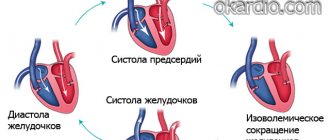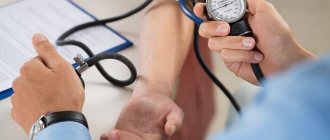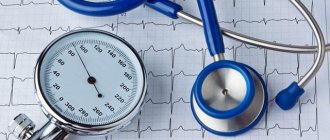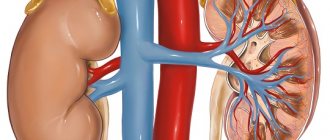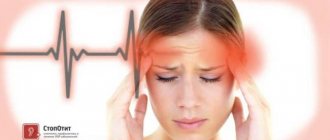Let's consider a pathology in which systolic pressure increases (upper) and diastolic pressure (lower) decreases, how this manifests itself clinically, what to do in this case, preventive measures.
The normal systolic (cardiac) blood pressure ranges from 110 to 130 units, and diastolic (renal) blood pressure ranges from 70 to 80. The difference between them, or pulse pressure, ranges from 30 to 40 units. For older people it is 50 units. If the upper pressure increases, but the lower pressure remains low, they speak of an increased pulse difference, which indicates cardiovascular or endocrine pathology.
Causes of pathology
The upper indicator is a marker of the condition of the heart and large vessels; it increases with arrhythmias, heart defects, and adrenal hyperactivity. The lower indicator is an indicator of vascular tone, which changes due to atherosclerotic plaques and decreased elasticity of the arteries.
A large pulse difference is caused by a combination of factors affecting the lower and upper levels of blood pressure, disruption of the thyroid gland, and age-related changes in the heart and blood vessels.
If we talk about specific diseases, we should note:
- post-infarction, post-stroke condition;
- atherosclerosis of the aorta;
- heart failure;
- nephritis-nephrosis;
- myocarditis;
- arrhythmias;
- hyperthyroidism.
What is upper pressure and how does it manifest itself?
The question of what systolic pressure is responsible for worries every hypertensive patient. The first numbers on the tonometer show the degree of blood pressure at the moment of maximum heart contraction. The higher they are, the more difficult it is for blood flow to move through the vessels. Lower (diastolic) pressure demonstrates how blood moves through the vessels from the heart to the next contraction. Since the lower indicators are passive, it is the upper numbers that are fundamental in diagnosing hypertension.
Not only high surface pressure against the background of increased, normal or decreased lower pressure indicates problems in the body. You can suspect something is wrong based on the following symptoms indicating the development of hypertension:
- dizziness;
- throbbing pain in the occipital or temporal region;
- noise in ears;
- nausea, vomiting;
- fainting;
- dyspnea;
- redness of the facial skin;
- “flies” before the eyes;
- heartache.
Important! If you find yourself with several signs from the list, it means that your upper blood pressure is high, which can lead to a series of complications, some of which are incompatible with life.
What is the danger of a large pulse difference?
Such a pathological condition threatens to deteriorate a person’s general well-being and reduce the quality of life. If the diastolic and systolic indicators change simultaneously, this is the worst case scenario. Constantly recorded extremely high upper pressure is a harbinger of a heart attack or stroke.
A large pulse difference can only be caused by a decrease in lower pressure, which indicates myocardial weakness, myopathy, cardiodilation, and loss of elasticity of the great vessels.
The pulse difference that accompanies isolated arterial hypertension (ISAH) indicates emerging complications of the heart, blood vessels, kidney disease, and atherosclerosis.
Reasons why lower blood pressure is high
A condition with a large difference in blood pressure that goes beyond physiological boundaries is called pathological. It speaks of organic or functional disorders of internal organs.
There are many reasons why there may be high lower pressure and low upper pressure. This ranges from the most harmless (such as climate change, prolonged physical activity, pregnancy, age) to diseases that lead to death.
This includes heart failure, congenital or acquired heart disease, coronary artery disease, hypertension, hypotension, and peripheral arterial disease.
Symptoms of the phenomenon
The situation is aggravated by the fact that at first hypertension, as a result of a large pulse difference, flows latently. As the pathology progresses, the following appears:
- chronic fatigue, weakness, fatigue;
- tachycardia, arrhythmia;
- chilling with simultaneous sweating;
- emotional lability, feelings of anxiety, fear, unmotivated panic;
- migraine;
- pulsation in the area of the back of the head, crown;
- insomnia;
- ataxia – partial loss of coordination;
- deterioration of attention, concentration, memory problems.
This is a common symptom. However, damage to a specific organ shows its symptoms.
Thyroid diseases
The most common variant of a large pulse difference is hypersecretion of thyroid hormones. You can suspect a malfunction of an organ if:
- tachycardia is constantly felt;
- hyperhidrosis;
- you always want to eat, but at the same time you constantly feel nauseous and have a stomach ache;
- causeless irritability, absent-mindedness;
- decreased erectile function in men, menstruation disorders in women.
Heart failure
It is a consequence of impaired myocardial conductivity or valve defects. In this case, the symptoms are as follows:
- chest pain;
- dyspnea;
- extrasystole, other heart rhythm disturbances;
- headache;
- pastiness.
Atherosclerosis
Can be total or local. Depending on the region where the vessels are affected, the symptoms are different. Coronary atherosclerosis provokes symptoms of heart failure of varying severity; damage to the arteries of the lower extremities leads to unpleasant sensations in the legs when walking, a burning sensation, numbness, heaviness; atherosclerosis of the abdominal aorta suggests a malnutrition of vital internal organs.
In this case, the patient experiences chills, flying pains in one or another place, dyspepsia, sometimes yellowness of the sclera, dry skin, and pre-syncope.
Symptoms
Regardless of the factor that caused the increase in PP, this is accompanied by headache, fatigue, and sleep disturbances.
Depending on the cause, high pulse pressure may be accompanied by a variety of symptoms.
Symptoms of hyperthyroidism
Most often, the difference between systolic and diastolic blood pressure is large in hyperthyroidism.
Excessive production of thyroid hormones can be recognized by the following symptoms:
- tachycardia (rapid heartbeat);
- sweating;
- abdominal pain, nausea, increased appetite;
- anxiety, irritability, forgetfulness;
- menstrual cycle disorders in women, weak potency in men.
Arrhythmias and valve defects
Various arrhythmias and valve defects are accompanied by typical signs of heart failure: chest pain, shortness of breath, attacks of increased and irregular heartbeat.
Atherosclerosis
Atherosclerosis, depending on the location, causes the appearance of different symptoms. The accumulation of cholesterol in the coronary vessels manifests itself as signs of heart failure. In peripheral vessels - chilliness in the extremities, periodic numbness.
Diagnostics
With a large pulse difference, we can speak with almost 100% certainty about damage to the cardiovascular or endocrine system. It is necessary to establish the exact cause of the pathology. To do this, after collecting anamnesis and physical examination, the following is prescribed:
- OAC, OAM – screening of the patient’s general condition;
- biochemistry: blood sugar, cholesterol, hormone testing;
- ECG, EchoCG (ultrasound of the heart);
- daily monitoring of Holter pressure (cardiogram or blood pressure).
Depending on the results obtained, Doppler ultrasound of blood vessels, CT, MSCT, and MRI may be prescribed. Identified endocrine pathology requires consultation with an endocrinologist with a manual examination of the thyroid gland, ultrasound of the organ, and a thyroid hormoneogram.
If a pathology of the heart or blood vessels is detected, the patient is referred to a cardiologist, who can prescribe a 3D tomogram of the myocardium. Only based on the analysis of all the data obtained, a final diagnosis is made.
Features of treatment
The basic rule for the treatment of large pulse differences is the treatment of the underlying pathology that caused such a phenomenon. However, there is also first aid for the sudden discovery of pathology, folk remedies, and diet.
Quick help at home
An attack of a large difference between DBP (diastolic blood pressure) and SBP (systolic blood pressure) is stopped as follows:
- you need to lie down on the bed, try to calm down;
- take an aspirin tablet to prevent thrombosis;
- drink a sedative: Corvalol, Valerian, Valocordin;
- no physical activity (!);
- call a doctor.
There is no need to do anything extra, since the reason that caused the large pulse difference is important, and only a doctor can determine it.
Treatment of provoking diseases
If the patient has a specific medication regimen that the doctor has developed individually for him, you need to follow his recommendations using:
- diuretics: Lasix, Triampur, Furosemide;
- beta blockers: Bisoprolol, Betalok, Propranolol (they are indicated for tachycardia);
- calcium antagonists: Nifedipine, Farmadipine, Isradipine.
In all other cases, consultation with a specialist is necessary to prescribe therapy for the disease causing AD.
However, you need to understand that if a large pulse difference is due to advanced age, severe atherosclerosis, severe heart defects, it will not be possible to cure the pathology, you can only alleviate the patient’s condition.
Hyperthyroidism
The essence of therapy is taking thyreostatics on an ongoing basis. They will block the hypersecretion of hormones, normalize hormonal levels in parallel with blood pressure. Used: Tyrosol, Metizol, Mercazolil. The patient is recommended a strict diet, in which the following are prohibited: coffee, chocolate, strong tea, spices, salt, and anything fatty. Recommended: milk, its derivatives, fruits, vegetables, lean meat.
Cardiovascular pathology
To maintain the heart and blood vessels, supporting drugs are used:
- containing potassium, magnesium: Panangin, Asparkam, Aspangin;
- calcium inhibitors: Diltiazem, Amlodipine, Verapamil;
In case of serious valvular heart defects, surgery is indicated.
Signs and consequences of low blood pressure
According to specialists from Carnelian MC, the manifestation of low blood pressure is typical for young women under the age group of 40 years.
Symptoms of disturbances include:
- insufficient blood circulation, leading to throbbing pain in the temporal region of the head;
- sudden change of mood;
- constant apathy, lethargy, feeling tired. The body is not able to recover after a good rest and sleep.
Low blood pressure can manifest itself for various reasons: as a result of previous infections, underweight, anemia, unfavorable work factors, changes in climatic conditions or seasonality. Also, pressure can change as a result of a lack of vitamins, indicating anemia, pre-infarction condition, weight deficiency, cardiosclerosis, VSD, renal failure, low hemoglobin, circulatory disorders, etc.
With a slight change in blood pressure, people live full lives. To avoid health problems, experts recommend exercise, adhere to a healthy lifestyle and proper nutrition, often walk in the fresh air, give up alcohol and take vitamins and fruits. A person should also avoid stress and take care of his health, constantly monitor his blood pressure and keep it normal. Measurements should be taken several times a week; you should not drink alcoholic drinks or coffee, play sports, smoke, or swim in hot water beforehand.
Folk remedies
The most effective are tinctures of ginseng and hawthorn, but they require consultation with a cardiologist.
Ginseng strengthens the myocardium because it contains cardiac glycosides, as well as blood vessels due to vitamins and minerals. You can buy a pharmacy version, or you can make it yourself: 10 g of crushed dry root is poured into 50 ml of 70% alcohol, left for three weeks. Take 15 drops three times a day for two weeks.
Side effects:
- simultaneously increases DBP, SBP;
- causes insomnia;
- dyspepsia;
- rapid heartbeat;
- nausea;
- nose bleed.
Contraindications common for children and adults:
- age under 18;
- hyperthermia;
- individual intolerance or allergy;
- pregnancy, lactation.
An alternative to tincture can be ginseng honey: 200 g of linden honey is mixed with 10 g of crushed fresh root, left for 25 days, then the root is removed and taken a teaspoon three times a day for a month.
Hawthorn – contains flavonoids that strengthen blood vessels, in addition:
- improve microcirculation of the brain and eyes;
- accelerate metabolic processes in the myocardium;
- dilate blood vessels, relieve pain;
- reduce blood sugar levels;
- have a calming effect.
You can buy the tincture at the pharmacy or make it yourself: 10 g of berries are poured with 100 g of alcohol, infused for three weeks. Take 30 drops three times a day, two and a half weeks: if cardiac glycosides or beta blockers are prescribed at the same time, adjust the dose, since hawthorn enhances the effect of the drugs. Side effects: bradycardia, dizziness. There are several contraindications:
- under 12 years old – taboo;
- gastritis, ulcer;
- liver failure;
- pregnancy, lactation;
- individual intolerance.
Children can drink hawthorn as tea.
Mulberry (mulberry) - the root contains essential oils, carotene, vitamins, improves myocardial function, has a positive effect on hemodynamics, and relieves anemia. It’s easy to prepare: pour 50 g into a glass of boiling water, leave for several hours, filter, drink 50 ml three times a day. May cause digestive upset. The only contraindications are individual intolerance.
Grapefruit - reduces the risk of stroke by strengthening blood vessels, improving microcirculation in capillaries, it is an antioxidant and anti-cholesterolemic product. Side effects include dizziness, rapid heartbeat, and facial flushing. Cannot be used for:
- increased stomach acidity;
- gastritis, stomach ulcer;
- hepatitis, enteritis, colitis;
- acute nephritis, cystitis
- not allowed when taking statins (!).
The advantage of grapefruit is its ability to correct lipid metabolism, that is, control weight.
Strawberry - tea made from leaves, fresh berries stimulate regenerative processes in the wall of blood vessels. Side effects may include skin rashes, itching, and anaphylaxis. Among the side effects, only allergies or individual intolerances were noted.
They also recommend honey mixed with walnuts, as well as kefir with ground cinnamon. All drugs gently lower blood pressure and normalize heart function.
Prevention
The fight against a high pulse difference, and therefore high systolic and low diastolic pressure, is a complex, lengthy process. It requires desire and patience, especially since it is impossible to completely eliminate the pathology. But keeping the indicators within the normal range is quite possible. To do this you need:
- lead a healthy lifestyle, quit smoking and alcohol;
- balance the diet, minimize salt, limit fat;
- regularly engage in physical exercise and sports;
- eliminate stress;
- include walking in your daily routine.
Seemingly simple rules greatly speed up the rehabilitation of patients and prevent complications. This will reduce the risk of complications and prolong the active longevity of patients.
Which pressure is more important - systolic or diastolic?
Continuously pumping blood, our heart makes dull sounds (they are called tones). Low, long sound - systolic - high, short - diastolic. On average, our heart beats 60-70 times per minute.
The intermediate time during which the heart pumps blood into the bloodstream is called systole.
During the beating process, the heart muscles contract, opening the valve with a characteristic sound, after which relaxation immediately occurs and the valve slams shut with a dull, diastolic sound.
Physiological pressure norms are purely individual. However, WHO decided to classify systolic pressure exceeding 135 mmHg, and diastolic pressure - from 90-100 mmHg. as hypertension.
